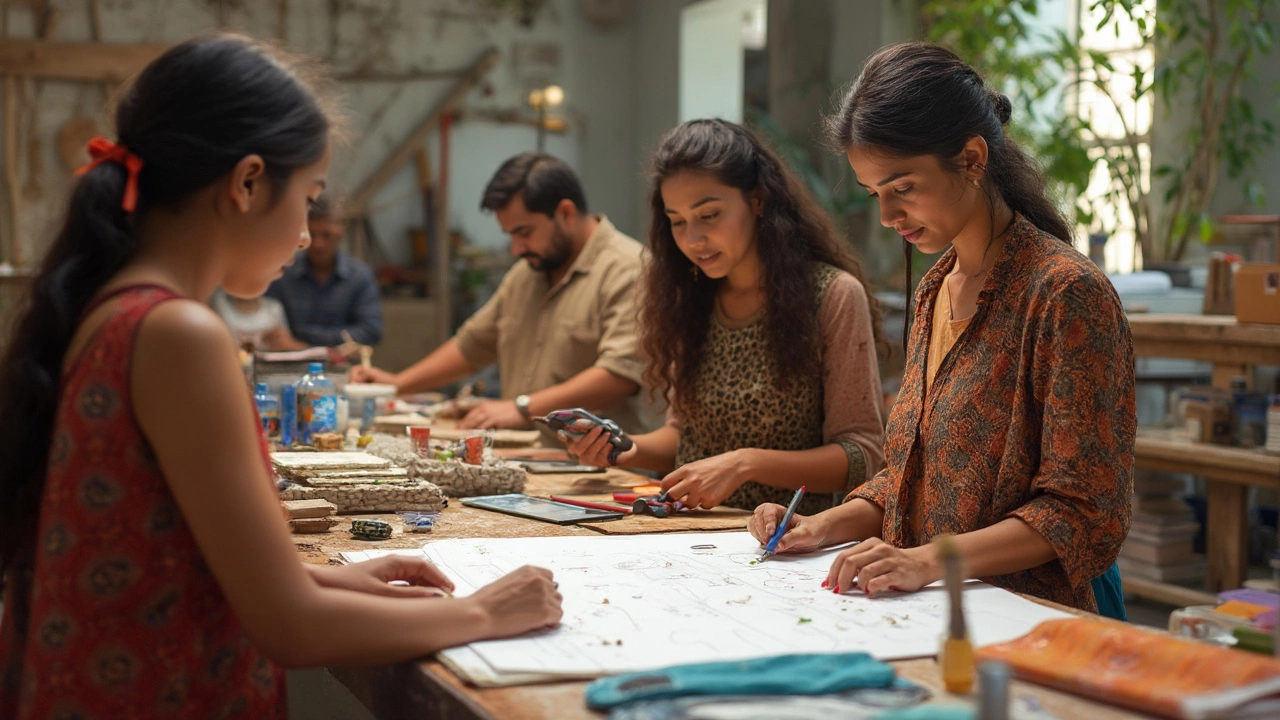Furniture Manufacturers India: Which Industry Will Boom in 2025?

Home used to be just a place to crash after work. Not anymore. With hybrid jobs and the rise of online everything, Indians are upgrading their living spaces in a big way—and it’s fueling a furniture revolution you don’t want to miss.
By 2025, India’s furniture industry is set to become one of the country’s breakout sectors. We’re talking about a market that could hit $40 billion, according to numbers tossed around in recent trade shows and by the Indian Brand Equity Foundation. That’s not a typo—$40 billion. Why? Urban homes are shrinking, people want “smart” spaces that max out every inch, and nobody wants the same cookie-cutter plywood bed as their neighbor anymore.
If you’re a builder, a designer, or just someone who cares about how your space looks, this is your moment. Local carpentry is seeing a comeback, while direct-to-doorstep startups are gaining traction with clever modular designs. Plus, bulky furniture shopping trips are out—the click-and-order revolution has sucked even the older generation into the online furniture game. Getting ahead is now less about raw muscle and more about speed, quality, and personal style. Ready to see what’s changing and why it’s such a big deal for India’s furniture makers?
- Why Furniture Is the Next Big Thing
- What’s Powering the Boom
- How Tech Is Changing the Game
- The Local Advantage
- Trends to Watch in 2025
- Tips for Furniture Makers and Shoppers
Why Furniture Is the Next Big Thing
Buying furniture used to mean finding the closest carpenter or visiting a crowded market. Now, things are different—India’s middle class has more cash to spend, and people care a lot more about how their homes look and feel. That’s a massive shift. Families are moving into apartments, city living is packed, and everyone wants furniture that fits—and actually looks good. No more one-size-fits-all old-school stuff.
Take a look at the numbers. Demand for quality furniture has exploded. Here’s what’s driving the action:
- India’s urban population just crossed 500 million in 2024 and is growing fast. That’s a lot of homes to furnish.
- E-commerce platforms like Pepperfry and Urban Ladder saw their furniture sales double from 2022 to 2024, pulling in both young shoppers and older buyers who now love the convenience of online shopping.
- Millennials and Gen Z care about customization—surveys show over 60% want furniture that matches their style and needs, not just whatever’s cheap or available.
Here’s a simple breakdown of what the furniture industry India looks like right now and what changes are happening:
| Year | Market Size (USD billions) | Major Driver |
|---|---|---|
| 2022 | 25 | Post-COVID demand surge |
| 2024 | 33 | Urbanization, digital sales |
| 2025 (projected) | 40+ | Customization & smart living |
Growth isn’t just about more sales—it’s about how people use space. Hybrid work has made home offices essential. People also want modular kitchens and furniture that doubles up (like sofa-cum-beds or storage ottomans). Cheap imports are falling out of favor as Indians are now choosing solid, locally made products.
If you’re thinking about a business move, watch what’s happening in cities like Bengaluru, Pune, and Hyderabad. These are the hot spots where trends start, and furniture makers are doubling down on quick delivery, great design, and eco-friendly materials. The boom isn’t coming, it’s already here, and it’s changing how India lives.
What’s Powering the Boom
The Indian furniture sector isn’t just having a moment—it's riding a tidal wave of change. Let’s talk about what’s actually pushing this boom:
- Urbanization: By 2025, over 40% of India’s population will be living in cities, according to the World Bank. Smaller homes mean people want furniture that fits their space and does double-duty.
- Rising Incomes: More people are spending on home upgrades. The median income is climbing, and with that, tastes are getting sharper. People don’t just want cheap, they want style and durability.
- Younger Buyers: Millennials and Gen Z buyers now make up over 60% of home-related purchases. They care about design, sustainability, and being able to order stuff with a tap on their phones.
- Work-from-Home Culture: After the pandemic, the demand for work desks, ergonomic chairs, and custom setups shot up. This trend is still strong, with companies polled by Naukri.com saying up to 40% of their workforce stays hybrid.
- E-commerce Explosion: Platforms like Pepperfry and Urban Ladder have shown that people are ready to order an entire living room set online. In fact, furniture e-commerce in India is projected to grow at a rate of 15% annually through 2025.
Here’s a look at some numbers driving the furniture industry India right now:
| Factor | Stat (2025 Projection) |
|---|---|
| Market Size | $40 Billion |
| Online Sales Share | 18% |
| Yearly Growth Rate | 15% |
| Urban Households Needing Furniture | Over 170 Million |
One thing you can’t ignore—India is still importing some big-ticket items, but local manufacturers are quickly catching up. With Make in India incentives and better access to quality raw materials, it’s suddenly more attractive to source furniture from within the country. Plus, buyers love that desi touch, whether it’s solid sheesham wood for a classic look or modular pieces that slide neatly under the bed when guests arrive.
All these changes mean the race is hot for any brand or carpenter who thinks ahead. It’s not about just making furniture—it’s about fitting into how people actually live, work, and chill at home in 2025.
How Tech Is Changing the Game
Forget the days when buying furniture meant flipping through dusty catalogues or wandering in circles at a warehouse. Now, tech is flipping the script for the furniture industry India—and the pace is wild.
3D visualization lets you see a sofa in your own living room before you spend a rupee. Companies use AR (Augmented Reality) apps right on your phone, so you can move a virtual coffee table around your home and see what fits. IKEA and Livspace are already rolling out these features, and smaller Indian brands aren’t far behind. That’s cutting down return rates and making people more confident to buy big-ticket items online.
Customization is the other big breakthrough. AI-driven platforms now let customers swap fabrics, colors, sizes, and configurations until it’s exactly what they want. Pepperfry, Urban Ladder, and a bunch of new startups have online designers or bots to walk you through the process. Basically, your dream furniture is just a few swipes away.
Supply chains are also getting a facelift. RFID tags and smart inventory tools mean manufacturers know what’s moving and what’s not—sometimes in real time. Not only does this kill those annoying out-of-stock notices, but it also speeds up delivery. Furniture orders that used to take three weeks can now turn up in a matter of days if you live in a metro area.
Here’s a quick snapshot of what’s happening in numbers:
| Tech Feature | Impact in India (2024-2025) |
|---|---|
| AR visualization | Used by over 35% of online furniture shoppers |
| AI customization | Available on more than 60% of leading platforms |
| Smart warehousing | Reduces lead times by 30% |
| Direct-to-door delivery tracking | Adopted by every major online brand |
If you’re shopping for furniture, test out those AR tools before you even think about buying. For manufacturers or sellers, jumping on these tech trends isn’t optional anymore—it’s table stakes if you want to survive 2025’s boom. Tech is making the market bigger, faster, and way more fun for everyone involved.

The Local Advantage
Here’s a cool thing many people miss: Indian furniture manufacturers have a major home-field advantage. Local makers know what Indian homes really need—think space-saving units, hardwood durability for our humid cities, and styles that blend with everything from old-school bungalows to high-rise apartments. You won’t find that kind of flexibility from big global brands.
Wood like teak, sheesham, and mango are pretty much native legends—strong, easy on the eyes, and loved for lasting decades. Plenty of international companies try to copy the look, but only Indian carpenters know how to work with these woods the old-fashioned way without wrecking the grain. Plus, buying local means you’re dodging crazy shipping fees and long waiting times. Products come fast, after-sales support is way smoother, and you actually get what’s promised.
There’s also a new energy on the scene: smaller local brands are eating up market share. Folks care about supporting homegrown businesses, but they also love the perks—like custom designs, repair services, and budget-friendly pricing. In fact, a report from India’s Ministry of MSME found that local workshops saw a 22% jump in orders from 2023 to 2024, mostly because people wanted tailor-made stuff for not much extra cost.
| Region | Main Wood Used | Popular Product |
|---|---|---|
| Jodhpur | Sheesham | Solid Wood Cabinets |
| Kochi | Teak | Dining Sets |
| Moradabad | Mango | Coffee Tables |
Another little-known tip: Locally made furniture meets Indian standards for durability and finishes, which can be tougher than what imported pieces offer. Extra humidity? Heavy festival decorations? Local makers plan for that! And since most of the furniture industry India is based in regional clusters—like Rajasthan, Kerala, and Uttar Pradesh—it creates jobs and keeps skills sharp.
- If you want quick delivery and custom sizes, always ask about city or state-based workshops.
- Say yes to local brands that offer post-sale repairs—outsiders rarely match the aftercare.
- Go for proven corners like Jodhpur or Saharanpur for woodwork built to survive Indian families.
Bottom line: Local manufacturers are built for India by people who actually get Indian homes. If you want style, strength, and a little pride in your purchase, staying local is the way to go.
Trends to Watch in 2025
Anyone thinking the Indian furniture scene is boring hasn't looked around lately. This year, a few big trends are shaping what people want and what manufacturers are scrambling to deliver.
First up: furniture industry India is getting smarter. Smart furniture—think beds that charge your devices, or desks with built-in lights—has moved from ultra-luxury to mainstream. In 2024, over 15% of all urban online furniture sales had some tech element according to RedSeer research, and that number is only going up this year.
Modular furniture is another burning trend. With city apartments shrinking and rents climbing, nobody wants bulky stuff that won’t fit. Modular sofas, storage under beds, and foldable tables are flying off virtual shelves. IKEA’s 2024 India sales report flagged a 30% jump in modular items, and local brands like Urban Ladder and Pepperfry are racing to launch new lines.
If you care about the planet—and more buyers do every year—sustainable furniture is on your radar. Bamboo chairs, recycled wood coffee tables, and vegan leather couches aren’t just buzzwords. According to a 2024 Godrej Interio survey, almost 40% of their new Delhi customers actively asked about eco-friendly materials.
“Indian consumers are making conscious decisions, choosing pieces that are not only stylish but also sustainable and space-saving.” – Rajiv Sinha, Managing Director, India Furniture Forum
Local craftsmanship is finally getting its due. Hand-carved pieces from Rajasthan or Eastern India, sometimes paired with modern touches, are winning over younger buyers who want their homes to stand out. Small workshops are listing online overnight, making authentic, locally-made stuff more accessible—and affordable—than ever before.
- Hybrid designs: Fusion styles mixing classic Indian motifs with Swedish minimalism are on-trend.
- Fast delivery: Amazon-style quick shipping is now an expectation, not just a perk.
- Personalization: Shoppers want custom finishes, fabric choices, and the ability to tweak measurements.
If you're looking to buy, or thinking of selling, keeping an eye on these trends isn’t just smart—it’s essential in a year that promises to be big for furniture makers and design lovers alike.
Tips for Furniture Makers and Shoppers
This industry’s about to take off, but just being in the right place isn’t enough—you gotta play smart. Here’s what furniture makers and buyers need to know if they want to win big in 2025.
furniture industry India is hot for two reasons: demand from young buyers and the boom in compact, city homes. If you’re building or selling, make stuff that actually fits into these new apartments. Multifunctional furniture is selling like never before—a coffee table that turns into a desk, or a sofa that flips into storage, that’s what’s getting added to carts right now.
- Digital first: Shoppers are researching and buying online—period. If you’re a maker, a solid Instagram and WhatsApp presence beats a fancy showroom now. Buyers, always check reviews, genuine photos, and after-sales policies. No more falling for pretty catalog pictures alone.
- Local and sustainable: Wood from sustainable sources is a dealbreaker for a lot of urban customers. In fact, a 2024 KPMG survey found that 53% of buyers in big Indian cities will pay extra for furniture made from recycled wood or local teak.
- Customization counts: Cookie-cutter designs? Pass. Offer options for fabric, size, and extra features. Buyers: Don’t hesitate to ask if something can be personalized—a lot of local workshops are eager for custom work.
- Fast delivery is king: No one wants to wait three months for a dining set. Makers, keep your logistics tight. Buyers, read the delivery fine print—if it sounds fishy, it probably is.
- Warranty matters: Too many shoppers ignore this, but it’s the difference between a happy purchase and a nightmare. Makers, make it easy to spot your warranty info. Buyers, don’t skip the fine print—especially if you’re purchasing online.
A well-known furniture executive recently told Mint,
“Design and delivery are now equal priorities. People will not wait or compromise, and they expect personalized solutions. Makers who ignore this will get left behind.”
If you’re a furniture maker in India, 2025 is your test. Embrace smaller, smarter, modular designs. Shoppers, the options have never been better—just do your homework before you swipe your card.





